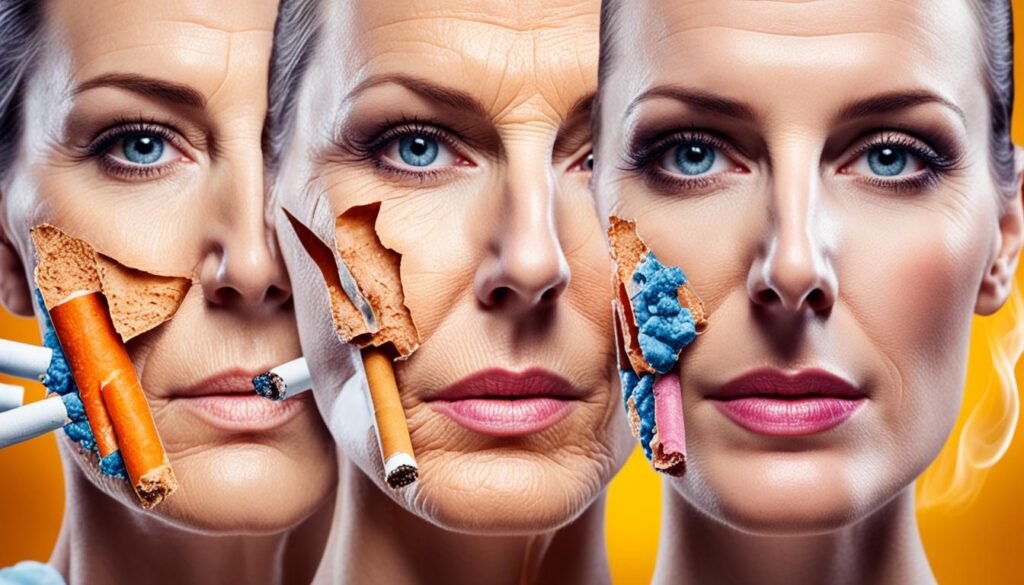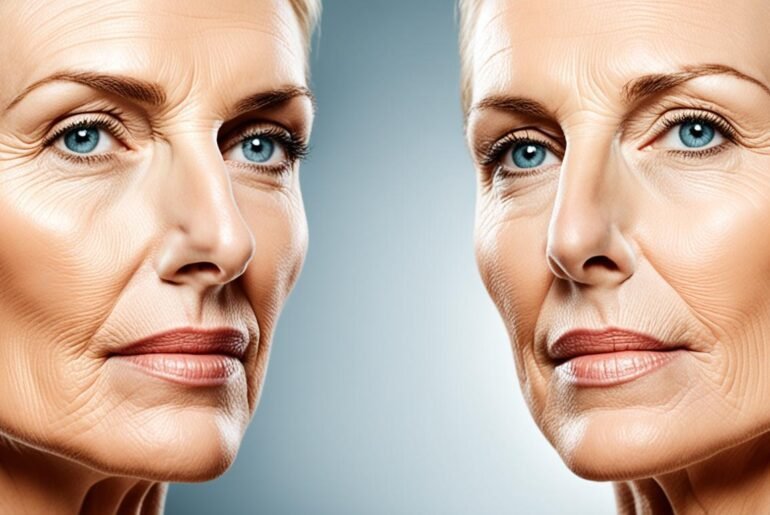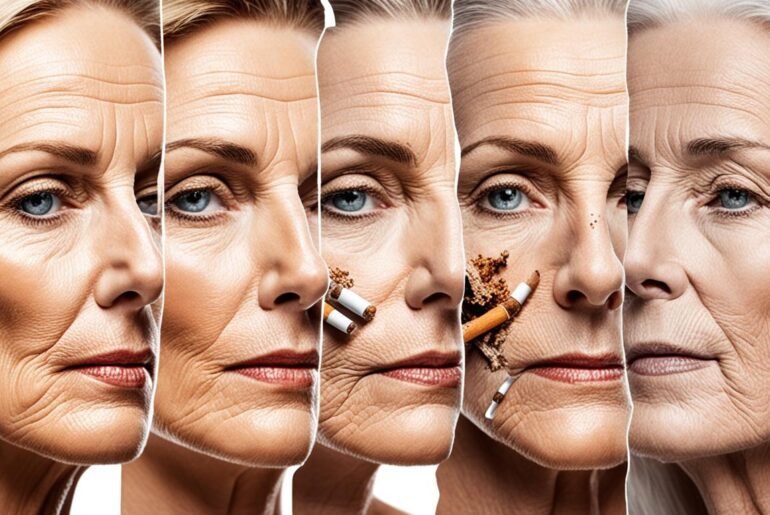Did you know that smoking can have a devastating effect on the collagen in your skin? Collagen is a protein that provides structure and elasticity to your skin, giving it a youthful and firm appearance. However, smoking can accelerate the degradation of collagen, leading to premature skin aging, wrinkles, and sagging.
Key Takeaways:
- Smoking decreases the synthesis rates of type I and III collagens in the skin.
- The levels of matrix metalloproteinases, enzymes that degrade collagen, are higher in smokers.
- Smoking leads to a decrease in skin elasticity due to the alteration of collagen turnover.
- Collagen depletion from smoking contributes to the formation of wrinkles and fine lines.
- Smoking also impairs wound healing and increases the risk of skin cancers.
The Impact of Smoking on Skin Health
Epidemiological studies have provided compelling evidence that tobacco smoking is closely linked to various detrimental effects on skin health. It is considered a strong independent predictor of facial wrinkle formation and premature skin aging. Recent studies have further substantiated these findings by demonstrating direct evidence of tobacco smoke causing premature skin aging. When individuals smoke, their skin undergoes molecular changes that contribute to these negative effects.
One of the key mechanisms through which smoking affects the skin is by impairing collagen biosynthesis. Collagen is a vital protein that provides structure, elasticity, and resilience to the skin. However, smoking interferes with the production of new collagen, leading to a breakdown in its formation. This disruption in collagen production ultimately compromises the health and appearance of the skin.
Additionally, smoking induces the activation of matrix metalloproteinases, or MMPs, which are enzymes responsible for collagen breakdown. These MMPs degrade collagen fibers, contributing to the loss of skin elasticity and the formation of wrinkles. The interaction between tobacco smoke and MMPs accelerates collagen degradation, further exacerbating the negative impact on skin health.
Overall, the effects of smoking on collagen degradation and skin health are evident. By disrupting collagen biosynthesis and promoting collagen breakdown, smoking leads to the premature aging of the skin, characterized by wrinkles, sagging, and a diminished overall resilience. It is crucial to raise awareness about the detrimental effects of smoking on skin health and promote smoking cessation for the sake of achieving optimal skin wellness.
| Effects of Smoking on Skin Health | Consequences |
|---|---|
| Impaired collagen biosynthesis | Reduces skin elasticity and resilience |
| Induction of matrix metalloproteinases (MMPs) | Leads to collagen breakdown and wrinkle formation |
| Premature skin aging | Results in the development of wrinkles, sagging skin, and overall loss of skin health |
Collagen Degradation from Smoking

The synthesis rates of type I and III collagens were found to be lower in the skin of smokers compared to non-smokers. Additionally, the levels of MMP-8, an enzyme involved in collagen degradation, were higher in smokers. These findings suggest that smoking leads to collagen degradation and loss, contributing to skin aging.
Smoking has a detrimental effect on collagen production and maintenance in the skin. The decreased synthesis rates of type I and III collagens in smokers result in a depletion of essential proteins responsible for the skin’s structural integrity and elasticity. Furthermore, the elevated levels of MMP-8 in smokers contribute to the breakdown and degradation of collagen.
Collagen is a crucial component of the extracellular matrix, providing support and strength to the skin. With collagen depletion, the skin becomes more susceptible to aging, leading to the formation of wrinkles, loss of firmness, and overall skin sagging.
The Impact of Smoking on Collagen Levels
Research has shown that smoking is a significant risk factor for collagen damage and depletion in the skin. The harmful chemicals in cigarette smoke, such as nicotine and carbon monoxide, directly interfere with collagen synthesis and disrupt the delicate balance of collagen turnover in the skin.
“Smoking not only decreases collagen synthesis but also disrupts the balance of extracellular matrix turnover in the skin.”
Collagen degradation from smoking involves the upregulation of MMP-8, an enzyme responsible for breaking down collagen fibers. The increased activity of MMP-8 in smokers accelerates collagen degradation, further exacerbating the loss of collagen in the skin.
“Collagen degradation from smoking involves the upregulation of MMP-8, an enzyme responsible for breaking down collagen fibers.”
The depletion of collagen due to smoking contributes to various skin aging signs, including fine lines, wrinkles, and a loss of skin elasticity. It also compromises the skin’s ability to heal wounds and maintain a healthy appearance.
| Type of Collagen | Synthesis Rates in Smokers | Synthesis Rates in Non-Smokers |
|---|---|---|
| Type I | Decreased | Normal |
| Type III | Decreased | Normal |
The table above summarizes the synthesis rates of type I and III collagens in smokers and non-smokers. It is evident that smoking leads to lower collagen synthesis compared to non-smokers, emphasizing the detrimental impact of smoking on collagen levels in the skin.
Smoking and Skin Elasticity
Smoking has a profound impact on the elasticity of the skin. The balance of collagen turnover is disrupted in smokers, leading to a decrease in the synthesis of type I and III collagens. These collagens are crucial for maintaining skin elasticity, firmness, and resilience. Unfortunately, cigarette smoking contributes to a noticeable loss of elasticity in smokers, resulting in sagging and wrinkling of the skin.
The decrease in collagen production caused by smoking is compounded by increased collagen degradation. As a result, the natural support structure of the skin weakens, leading to a loss of elasticity and a more aged appearance. This process can be particularly evident in areas of the face exposed to smoking, such as around the lips and eyes.
Research has shown that smoking-induced collagen loss can be severe. In a study comparing smokers and non-smokers, it was found that smokers had significantly lower skin elasticity measurements compared to non-smokers. This demonstrates the significant impact of smoking on skin health and appearance.
Considering the detrimental effects of smoking on collagen production and skin elasticity, it is crucial for individuals to understand the risks and make informed decisions about their smoking habits. Quitting smoking can help to mitigate the damage done to collagen and the skin, improving elasticity and overall skin health.
The Link Between Smoking and Skin Aging

Smoking has a profound impact on skin health, contributing to premature aging and a host of aesthetic concerns. The detrimental effects of smoking extend beyond the surface, reaching deep within the skin’s structure. The consequences of smoking on collagen synthesis and extracellular matrix turnover are particularly notable.
When a person smokes, the harmful chemicals present in tobacco smoke travel through the bloodstream and directly affect the skin’s health and integrity. One of the most significant effects of smoking is the decrease in collagen synthesis. Collagen, a protein responsible for maintaining the skin’s strength and elasticity, is essential for youthful-looking skin.
Furthermore, smoking disrupts the balance of extracellular matrix turnover. The extracellular matrix plays a crucial role in supporting the skin’s structure and function. Matrix metalloproteinases (MMPs), enzymes responsible for collagen breakdown, become overactivated in smokers, leading to accelerated collagen degradation and compromised skin health.
These changes in collagen synthesis and matrix turnover ultimately manifest as visible signs of premature aging on the skin. Wrinkles become more pronounced, skin sags, and overall skin resilience diminishes. The effects of smoking on skin aging are a cause for concern, as they result in a loss of vitality and contribute to an aged appearance.
“The detrimental effects of smoking on collagen synthesis and extracellular matrix turnover are particularly notable.”
It is important to raise awareness about the impacts of smoking on skin health and promote smoking cessation to mitigate these effects. Quitting smoking can help improve collagen synthesis, reduce collagen degradation, and restore the skin’s natural resilience. By quitting smoking, individuals can protect their skin, slow down the aging process, and maintain a vibrant and youthful complexion.
| Effects of Smoking on Skin Aging | Consequences |
|---|---|
| Decreased collagen synthesis | Formation of wrinkles and fine lines |
| Disruption of extracellular matrix turnover | Sagging skin and loss of resilience |
| Accelerated collagen degradation | Increased visibility of aging signs |
Smoking accelerates the aging process and compromises skin health. The negative effects on collagen synthesis and extracellular matrix turnover lead to visible signs of premature aging. Quitting smoking and adopting a healthy lifestyle can help preserve the skin’s vitality and maintain a youthful appearance.
The Effects of Smoking on Collagen Production
Smoking has a detrimental impact on collagen production in the skin, which is essential for maintaining its structural integrity and elasticity. The decrease in collagen production due to smoking contributes to skin aging, leading to the development of wrinkles and fine lines.
Collagen is a crucial protein that forms the scaffolding of the skin, providing strength and support. It is responsible for maintaining the skin’s firmness and elasticity, giving it a youthful appearance. However, the harmful chemicals in cigarette smoke can disrupt the production of collagen, causing a host of skin-related issues.
Research studies have shown that smoking decreases the production of type I and III collagens, which are the major components of the skin’s extracellular matrix. These collagens give the skin its structure and flexibility, allowing it to bounce back after stretching or contracting.
“The decrease in collagen production due to smoking contributes to skin aging and the development of wrinkles and fine lines.”
When the production of collagen is compromised, the skin loses its ability to maintain its structure and elasticity. As a result, the skin becomes more prone to damage from external factors, such as exposure to sunlight and environmental pollutants. It also becomes less resilient, making it difficult for wounds to heal and leaving scars more prominent.
Studies have shown that cigarette smoke contains harmful chemicals that can directly damage collagen fibers in the skin, leading to collagen breakdown and loss.
Smoking not only inhibits collagen production but also activates matrix metalloproteinases (MMPs), enzymes that degrade collagen. The combination of reduced collagen synthesis and increased collagen degradation accelerates the breakdown of collagen fibers in the skin, exacerbating the signs of skin aging.
To illustrate the effects of smoking on collagen production, a comparison can be made between smokers and non-smokers:
| Smokers | Non-Smokers | |
|---|---|---|
| Type I Collagen | Decreased production | Normal production |
| Type III Collagen | Reduced synthesis | Optimal synthesis |
Smokers experience a decrease in the production of type I collagen and a reduction in the synthesis of type III collagen compared to non-smokers.
These findings highlight the significant impact of smoking on collagen production and the negative consequences it has on skin health. By quitting smoking, individuals can protect and preserve their collagen levels, maintaining healthier and more youthful-looking skin.
The Role of Matrix Metalloproteinases (MMPs) in Collagen Degradation

Matrix metalloproteinases (MMPs) are enzymes that play a crucial role in collagen degradation, contributing to the overall health and integrity of the skin. Among the MMPs, MMP-8 has been identified as a key enzyme involved in collagen breakdown.
Research studies have demonstrated that smoking, a common yet harmful habit, can induce the expression of MMP-8, resulting in increased collagen degradation. This process further exacerbates the damage to collagen, leading to premature aging of the skin and the development of various skin concerns.
Collagen, a vital protein found abundantly in the skin, provides structural support and contributes significantly to its elasticity and firmness. However, smoking disrupts this delicate balance by upregulating MMP-8, which breaks down collagen fibers.
The increased collagen degradation caused by smoking not only leads to the formation of wrinkles and fine lines but also compromises the overall texture and resilience of the skin. Over time, this collagen damage contributes to the premature aging and deterioration of the skin’s appearance.
The Effect of Smoking on MMP-8 Expression and Collagen Degradation
Studies have demonstrated a clear association between smoking and elevated levels of MMP-8 in the skin. This increased expression of MMP-8 results in heightened collagen breakdown, undermining the skin’s structural integrity and contributing to various signs of aging.
To visualize the impact of smoking on collagen degradation, let’s compare the collagen turnover in the skin of smokers and non-smokers:
| Group | MMP-8 Levels | Collagen Degradation |
|---|---|---|
| Smokers | Elevated | Increased |
| Non-Smokers | Normal | Healthy |
The table clearly illustrates the significant impact of smoking on MMP-8 levels and collagen degradation in the skin. Smokers experience elevated MMP-8 levels, leading to increased collagen breakdown and deterioration of skin health.
It’s important to note that reducing collagen breakdown and maintaining healthy MMP-8 levels are essential for preserving the skin’s youthful appearance and preventing premature aging.
“The increased expression of MMP-8 caused by smoking accelerates collagen degradation and contributes to the premature aging of the skin.”
The Link Between MMP-8, Collagen Degradation, and Premature Aging
The relationship between MMP-8, collagen degradation, and premature aging is significant in understanding how smoking affects the skin. As smoking induces MMP-8 expression, the elevated levels of this enzyme contribute to the breakdown of collagen, a crucial component responsible for the skin’s strength and elasticity.
The detrimental effects of smoking on collagen degradation and premature aging can be summarized as follows:
- Smoking increases MMP-8 levels
- Elevated MMP-8 leads to increased collagen degradation
- Collagen breakdown accelerates premature aging of the skin
By understanding the role of MMP-8 in collagen degradation, we can better comprehend the harmful consequences of smoking on the skin and emphasize the urgency of quitting this detrimental habit.
Smoking and Collagen Turnover

Smoking has a profound effect on the turnover of collagen in the skin. Collagen, a vital protein for maintaining skin health and appearance, undergoes a delicate balance of synthesis and degradation. However, smoking disrupts this equilibrium, leading to a decrease in collagen production and an increase in collagen breakdown.
Collagen synthesis, the process of creating new collagen fibers, is negatively impacted by smoking. Research has demonstrated that smoking reduces the synthesis rates of type I and III collagens in the skin. These collagens are crucial for maintaining the structural integrity and elasticity of the skin, promoting a youthful and smooth complexion.
Furthermore, smoking contributes to an upregulation of collagen degradation. The elevated expression of matrix metalloproteinases (MMPs), enzymes responsible for breaking down collagen, is observed in smokers. In particular, MMP-8, an enzyme associated with collagen degradation, is higher in smokers compared to non-smokers.
“The disruption in collagen turnover caused by smoking leads to collagen depletion and compromises the health and appearance of the skin.”
This imbalance in collagen turnover ultimately results in collagen depletion in the skin. The decreased synthesis combined with the increased degradation creates an environment where the production of new collagen fails to keep up with its breakdown. As a result, the skin becomes more susceptible to signs of aging, such as the formation of wrinkles, sagging, and a loss of overall skin resilience.
To better illustrate the impact of smoking on collagen turnover, let’s take a closer look at the data:
| Comparison of Collagen Turnover in Smokers and Non-Smokers | Collagen Synthesis | Collagen Degradation |
|---|---|---|
| Non-Smokers | Normal synthesis rates of type I and III collagens | Lower levels of matrix metalloproteinases |
| Smokers | Decreased synthesis rates of type I and III collagens | Elevated levels of matrix metalloproteinases, including MMP-8 |
The table clearly demonstrates that smoking disrupts collagen turnover, leading to decreased collagen synthesis and increased collagen degradation. This imbalance can have significant implications for skin health and contribute to the visible signs of aging associated with smoking.
Other Effects of Smoking on Skin Health

In addition to collagen degradation, smoking can have various other negative effects on the health of your skin. These effects extend beyond premature aging and can impact the overall appearance and well-being of your skin.
Impaired Wound Healing
One of the consequences of smoking is impaired wound healing. Smoking restricts blood vessels, reducing the flow of oxygen and nutrients to the tissues. This impairs the body’s ability to repair itself, leading to delayed healing of wounds and increased risk of infection.
Increased Risk of Skin Cancers
Studies have shown a strong association between smoking and an increased risk of developing certain skin cancers, such as basal cell carcinoma and melanoma. The harmful chemicals in tobacco smoke can damage the DNA in your skin cells, increasing the likelihood of abnormal cell growth and the formation of cancerous lesions.
Changes in Skin Coloration
Smoking can also cause changes in skin coloration. Acne is more common in smokers, likely due to the clogging of pores and increased sebum production. Additionally, smoking can lead to oral melanin pigmentation, causing dark spots to appear on the gums and inside the mouth.
Smoking not only accelerates the aging process but also increases the risk of developing skin cancers and disrupts the natural coloration of your skin.
It is important to be aware of these additional effects of smoking on your skin health. Quitting smoking can not only help prevent premature aging but also improve overall skin wellness and reduce the risk of skin-related issues.
With a comprehensive understanding of how smoking affects collagen degradation and skin health, it is clear that smoking is detrimental to the appearance and vitality of the skin. By quitting smoking, individuals can mitigate these negative effects, improve the condition of their skin, and promote overall well-being.
Conclusion
Smoking has a significant impact on collagen degradation and skin health. The harmful effects of smoking on collagen production are evident, as it decreases collagen synthesis and disrupts the balance of extracellular matrix turnover. These changes contribute to premature aging, loss of elasticity, and various other skin-related issues.
It is crucial to raise awareness about the detrimental effects of smoking on skin health. Quitting smoking can lead to improved collagen production and better skin wellness. By quitting, individuals can not only reduce the risk of premature aging but also promote overall skin health and vitality.
Take control of your skin’s health by saying no to smoking. Quitting this harmful habit may help restore collagen production and prevent further damage, allowing your skin to regain its natural radiance and resilience.
FAQ
How does smoking affect collagen in the skin?
Smoking decreases collagen synthesis and alters the balance of collagen turnover, leading to collagen degradation and loss.
What are the effects of smoking on skin health?
Smoking has been associated with premature skin aging, including the formation of wrinkles, sagging skin, and loss of overall skin resilience.
Does smoking affect skin elasticity?
Yes, smoking has been found to decrease skin elasticity due to the disrupted balance of collagen turnover.
How does smoking contribute to skin aging?
Smoking decreases collagen production, increases collagen degradation, and disrupts the balance of extracellular matrix turnover, leading to skin aging.
What is the role of collagen in the skin?
Collagen is essential for maintaining the structural integrity and elasticity of the skin.
How does smoking affect collagen production?
Smoking reduces the production of type I and III collagens in the skin, contributing to skin aging and the development of wrinkles and fine lines.
What are the effects of matrix metalloproteinases (MMPs) in collagen degradation?
Matrix metalloproteinases (MMPs), induced by smoking, degrade collagen, further contributing to collagen damage and premature aging of the skin.
How does smoking affect collagen turnover?
Smoking disrupts the balance of collagen turnover in the skin, leading to decreased collagen synthesis and increased collagen degradation.
Are there other negative effects of smoking on skin health?
Yes, smoking has been associated with impaired wound healing, increased risk of skin cancers, and changes in skin coloration.
What is the connection between smoking and collagen production?
Smoking decreases collagen synthesis and disrupts collagen turnover, leading to collagen depletion and compromised skin health.




